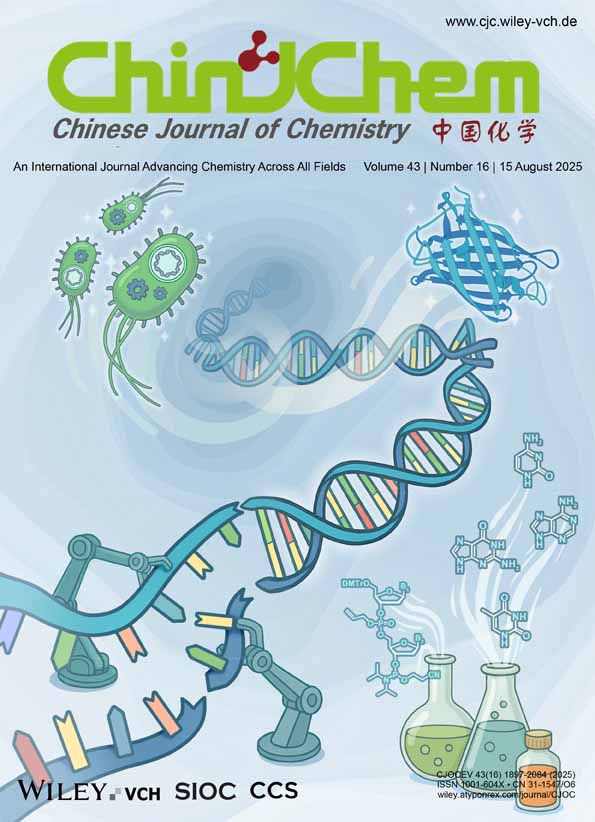Ligand Bridged and Bis-ligand Coordinated Titanium Complexes: Synthesis, Structure and Relevance to Phenylacetylene Hydroanilination Catalysis
Xiao-Yu Han
Key Laboratory of Organic Synthesis of Jiangsu Province, College of Chemistry and Chemical Engineering, Suzhou University, Suzhou, Jiangsu 215123, China
Search for more papers by this authorYa-Hong Li
Key Laboratory of Organic Synthesis of Jiangsu Province, College of Chemistry and Chemical Engineering, Suzhou University, Suzhou, Jiangsu 215123, China
State Key Laboratory of Applied Organic Chemistry, Lanzhou University, Lanzhou, Gansu 730000, China
Tel.: 0086-0512-65880323; Fax: 0086-0512-65880089
Search for more papers by this authorHua Wei
Key Laboratory of Organic Synthesis of Jiangsu Province, College of Chemistry and Chemical Engineering, Suzhou University, Suzhou, Jiangsu 215123, China
Search for more papers by this authorYong Zhang
Key Laboratory of Organic Synthesis of Jiangsu Province, College of Chemistry and Chemical Engineering, Suzhou University, Suzhou, Jiangsu 215123, China
Search for more papers by this authorXiao-Yu Han
Key Laboratory of Organic Synthesis of Jiangsu Province, College of Chemistry and Chemical Engineering, Suzhou University, Suzhou, Jiangsu 215123, China
Search for more papers by this authorYa-Hong Li
Key Laboratory of Organic Synthesis of Jiangsu Province, College of Chemistry and Chemical Engineering, Suzhou University, Suzhou, Jiangsu 215123, China
State Key Laboratory of Applied Organic Chemistry, Lanzhou University, Lanzhou, Gansu 730000, China
Tel.: 0086-0512-65880323; Fax: 0086-0512-65880089
Search for more papers by this authorHua Wei
Key Laboratory of Organic Synthesis of Jiangsu Province, College of Chemistry and Chemical Engineering, Suzhou University, Suzhou, Jiangsu 215123, China
Search for more papers by this authorYong Zhang
Key Laboratory of Organic Synthesis of Jiangsu Province, College of Chemistry and Chemical Engineering, Suzhou University, Suzhou, Jiangsu 215123, China
Search for more papers by this authorAbstract
Two ligand bridged binuclear titanium complexes Ti2(bppda)3(NMe2)2·3THF (1) and Ti2(bppda)3(NEt2)2·3THF (2) and one bis-ligand coordinated mononuclear complex Ti(bppda)2 (3) (ligand: H2bppdaN,N′-Bis(2-pyrrylmeth-ylidene)-1,2-phenylenediamine) were synthesized by adjusting the ratio of the starting materials and the reaction speed. The complexes were fully characterized with NMR, elemental analysis and X-ray crystal diffraction. The catalytic activity of the complex 1 to phenylacetylene hydroanilination reaction was also investigated.
REFERENCES
- 1 anerjee, S.; Shi, Y.; Cao, C.; Odom, A. L.. J. Organomet. Chem., 2005, 690, 5066.
- 2 Francisco, A.; Irina, P. B.; Miguel, Y.. Chem. Rev., 2004, 104, 3079.
- 3 Muller, T. E.; Beller, M.. Chem. Rev., 1998, 98, 675.
- 4 Esteruelas, M. A.; Lopez, A. M.; Mateo, A. C.; Enrique, O.. Organometallics, 2006, 25, 1448.
- 5 Doye, S.. Synlett, 2004, 10, 1653.
- 6 Andreas, H.; Frauke, P.; Doye, S.. Chem. Eur. J., 2004, 10, 3059.
- 7 Smolencky, E.; Kapon, M.; Eisen, M. S.. Organometallics, 2005, 24, 5495.
- 8 Cao, C.; Ciszewski, J. T.; Odom, A. L.. Organometallics, 2002, 21, 5148.
- 9 Hazari, N.; Mountford, P.. Acc. Chem. Res., 2005, 38, 839.
- 10 Lorber, C.; Choukroun, R.; Vendier, L.. Organometallics, 2004, 23, 1845.
- 11 Ackermann, L.; Bergman, R. G.; Loy, R. N.. J. Am. Chem. Soc., 2003, 125, 11956.
- 12 Zhang, Z.; Schafer, L. L.. Org. Lett., 2003, 5, 4733.
- 13 Tillack, A.; Khedkar, V.; Jiao, H. J.. Eur. J. Org. Chem., 2005, 23, 5001.
- 14 Khedkav, V.; Tillack, A.; Beller, M.. Org. Lett., 2003, 5, 4767.
- 15 Petersen, J. R.; Hoover, J. M.; Kassel, W. S.; Rheingold, A. L.; Johnson, A. R.. Inorg. Chim. Acta, 2005, 358, 687.
- 16 Odom, A. L.. J. Chem. Soc., Dalton Trans., 2005, 225.
- 17 Berube, C. D.; Gambarotta, S.; Yap, G. P. A.. Organometallics, 2003, 22, 434.
- 18 Bradley, D. C.; Thomas, I. M.. Proc. Chem. Soc., 1959, 225.
- 19 Bradley, D. C.; Thomas, I. M.. J. Chem. Soc., 1960, 3857.
- 20 Bradley, D. C.. Adv. Inorg. Chem. Radiochem., 1972, 15, 259.
- 21 Li, Y.; Shi, Y.; Odom, A. L.. J. Am. Chem. Soc., 2004, 126, 1794.
- 22 Mullins, S. M.; Duncan, A. P.; Bergman, R. G.. Inorg. Chem., 2001, 40, 6952.
- 23 Abarca, A.; Gomez, P.; Martin, A.; Yelamos, C.. Inorg. Chem., 2000, 39, 642.
- 24 Kuwata, S.; Nagano, T.; Matsubayashi, A.; Ishii, Y.; Hidai, M.. Inorg. Chem., 2002, 41, 4324.
- 25 Davidson, M. G.; Jones, M. D.; Lunn, M. D.. Inorg. Chem., 2006, 45, 228.
- 26 Gomez, P.; Martin, A.; Mena, M.; Yelamos, C.. Inorg. Chem., 1996, 35, 242.
- 27 Bennett, J. L.; Wolczanski, P. T.. J. Am. Chem. Soc., 1997, 119, 10696.
- 28 Mire, L. W.; Margnick, D. S.. Inorg. Chem., 2000, 39, 5970.
- 29 Li, H. B.; Li, L.; Marks, T. J.; Louise, L. S.; Kheingold, A. L.. J. Am. Chem. Soc., 2003, 125, 10788.
- 30 Li, Y.; Turnas, A.; Ciszewski, J. T.; Odom, A. L.. Inorg. Chem., 2002, 41, 6298.




